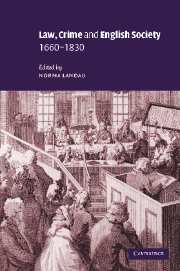Book contents
- Frontmatter
- Contents
- List of figures
- Notes of contributors
- 1 Introduction
- Part 1 Law
- Part 2 Crime
- Part 3 Society
- 8 After Somerset: Mansfield, slavery and the law in England, 1772–1830
- 9 Religion and the Law: evidence, proof and ‘matter of fact’, 1660–1700
- 10 The press and public apologies in eighteenth-century London
- 11 Origins of the factory acts: The Health and Morals of Apprentices Act, 1802
- John M. Beattie's publications
- Index
8 - After Somerset: Mansfield, slavery and the law in England, 1772–1830
from Part 3 - Society
Published online by Cambridge University Press: 30 June 2009
- Frontmatter
- Contents
- List of figures
- Notes of contributors
- 1 Introduction
- Part 1 Law
- Part 2 Crime
- Part 3 Society
- 8 After Somerset: Mansfield, slavery and the law in England, 1772–1830
- 9 Religion and the Law: evidence, proof and ‘matter of fact’, 1660–1700
- 10 The press and public apologies in eighteenth-century London
- 11 Origins of the factory acts: The Health and Morals of Apprentices Act, 1802
- John M. Beattie's publications
- Index
Summary
The Somerset case
In June 1772 Lord Mansfield freed a single slave and made legal history. From that day onwards there was no slavery in England. Or was there? Just what Lord Mansfield achieved that day remains a matter for speculation and controversy. This chapter seeks to re-examine the immediate aftermath of Somerset in the light of fresh evidence, in order to determine just what effect it had upon the legal status of slaves in England until slavery was abolished throughout the British Empire in the early 1830s.
The case of James Somerset is well known. He was brought as a slave from the Americas to England, ran away, was recaptured and then imprisoned on a ship bound for the West Indies. In response to a writ of habeas corpus, the captain returned that Somerset was a slave who had absconded from his master's service and refused to return, and that he had been delivered over in order to be returned to Jamaica, where he would be sold. Lord Mansfield declared the return unlawful, stating that ‘Slavery is so odious that it must be construed strictly’ and derive from positive law, and that ‘No Master was ever allowed here to send his servant abroad because he absented himself from his service or for any other cause.’
- Type
- Chapter
- Information
- Law, Crime and English Society, 1660–1830 , pp. 165 - 184Publisher: Cambridge University PressPrint publication year: 2002
- 13
- Cited by



